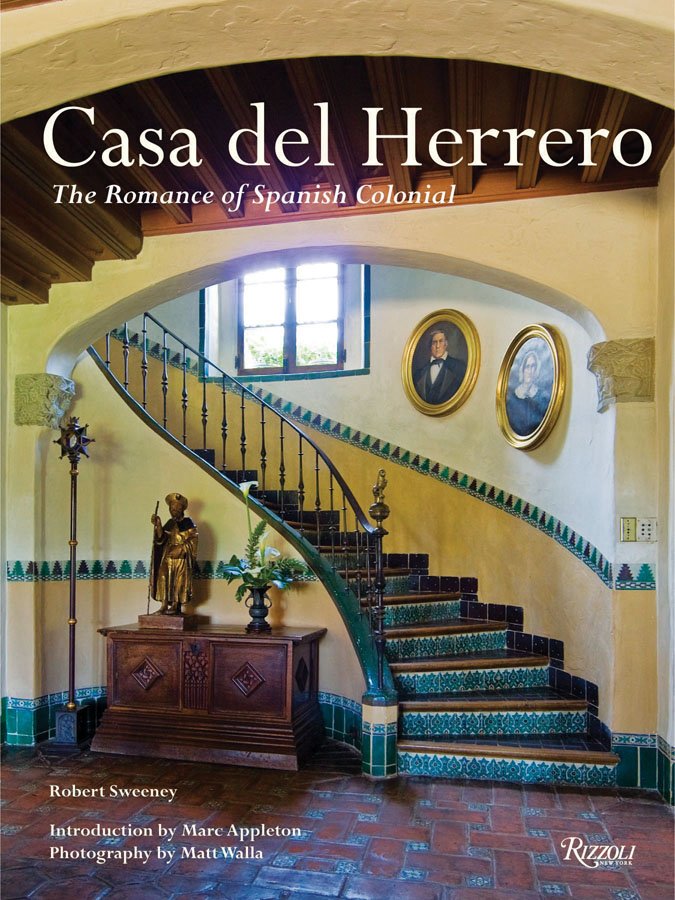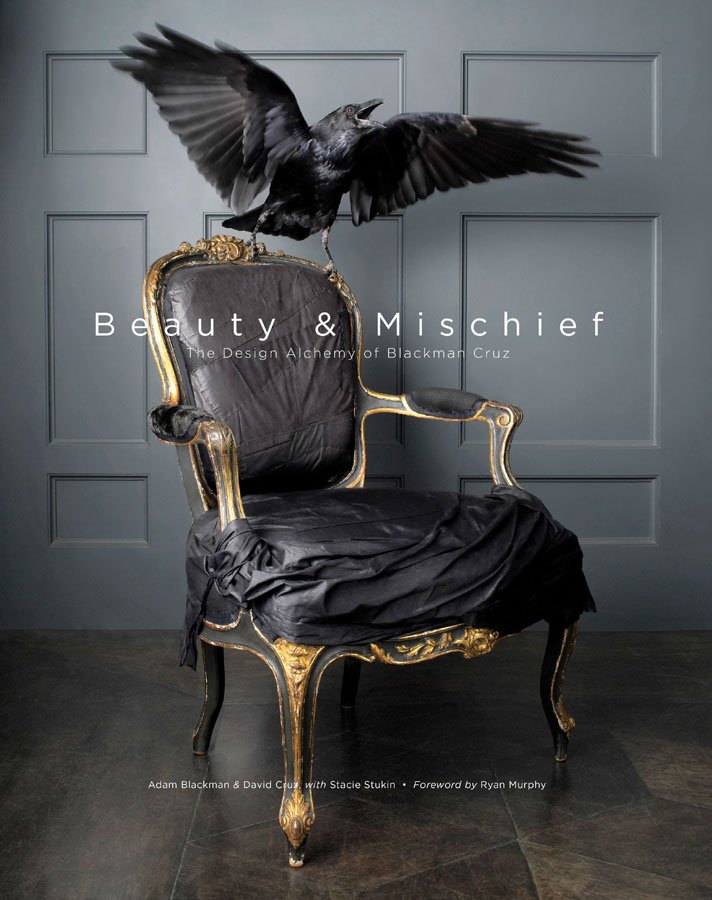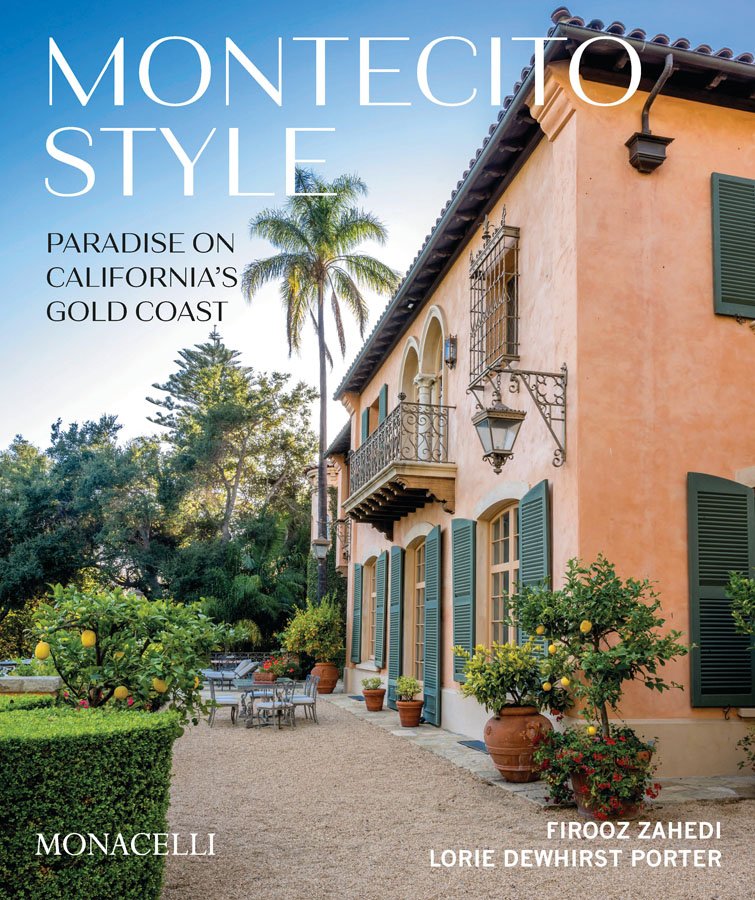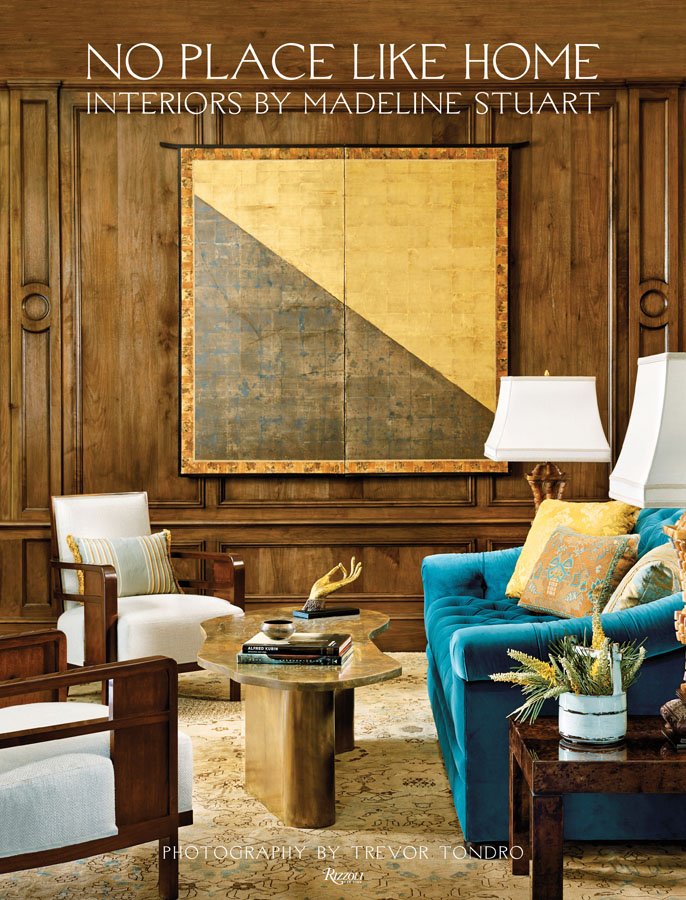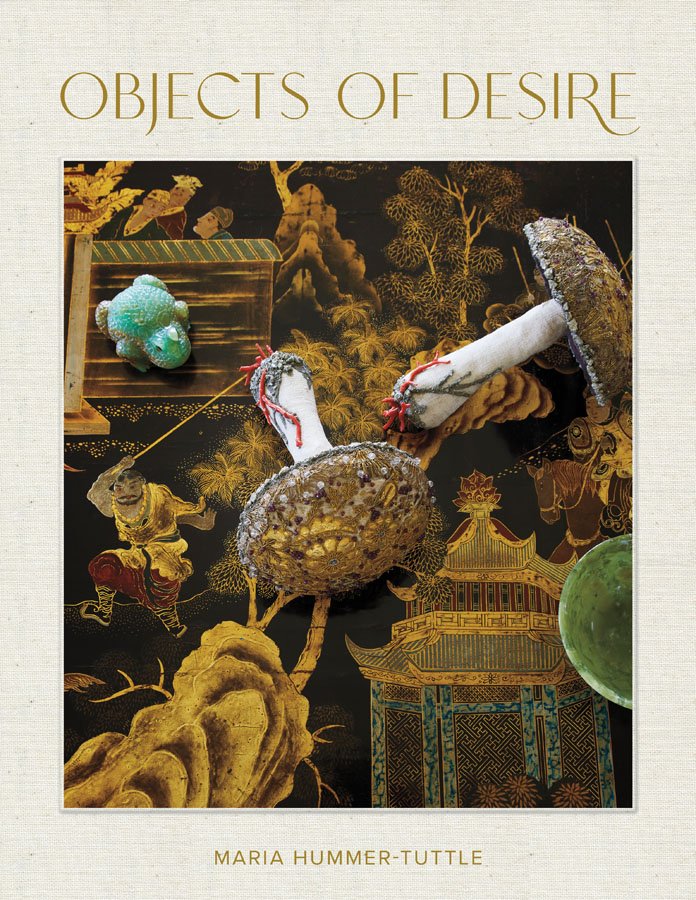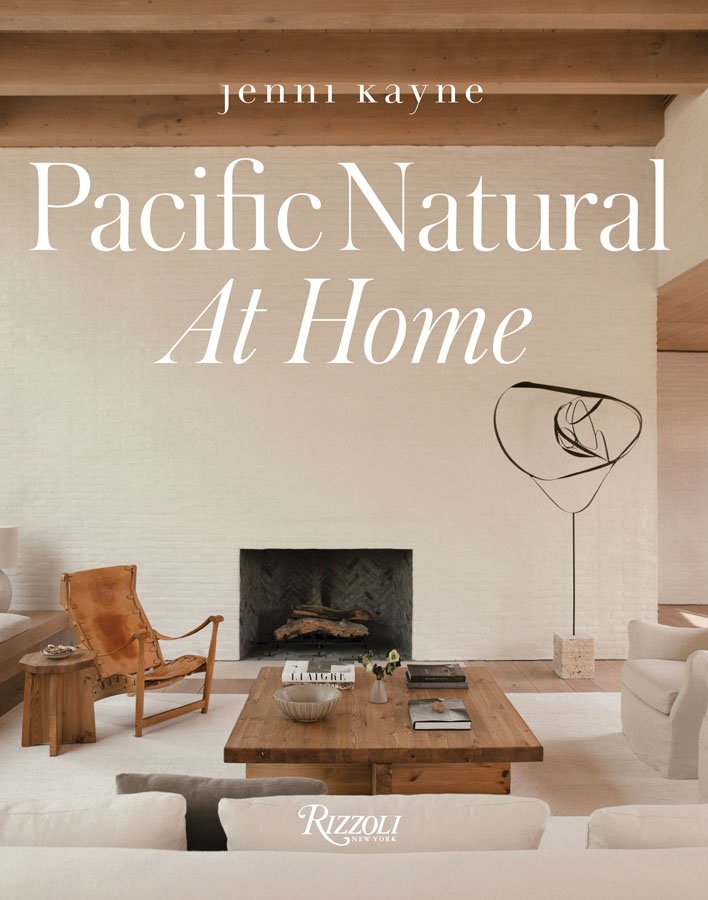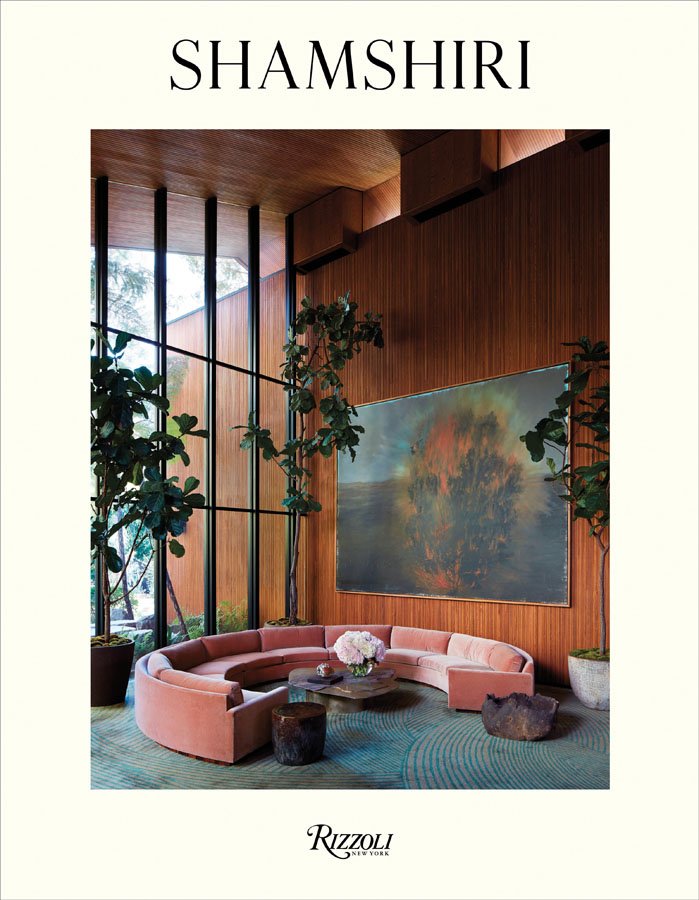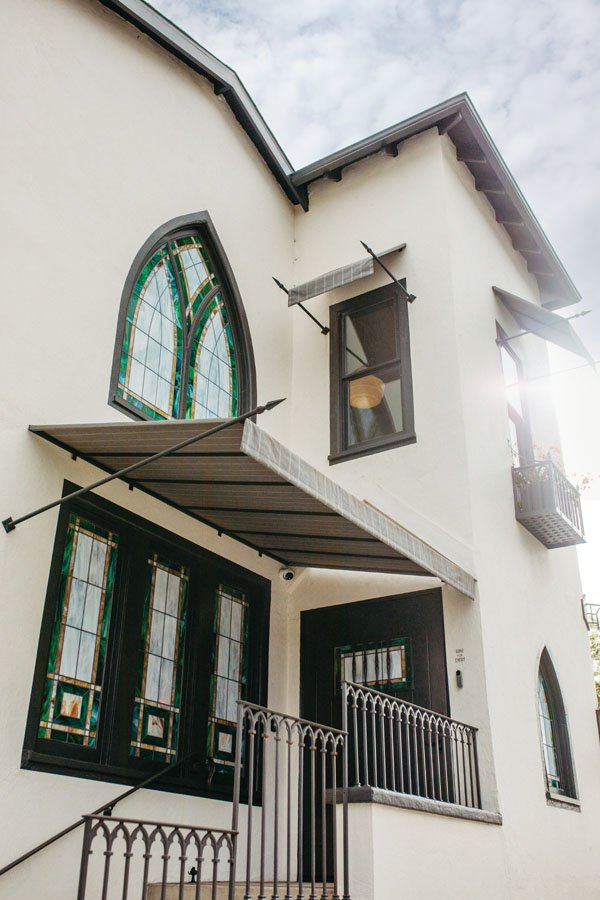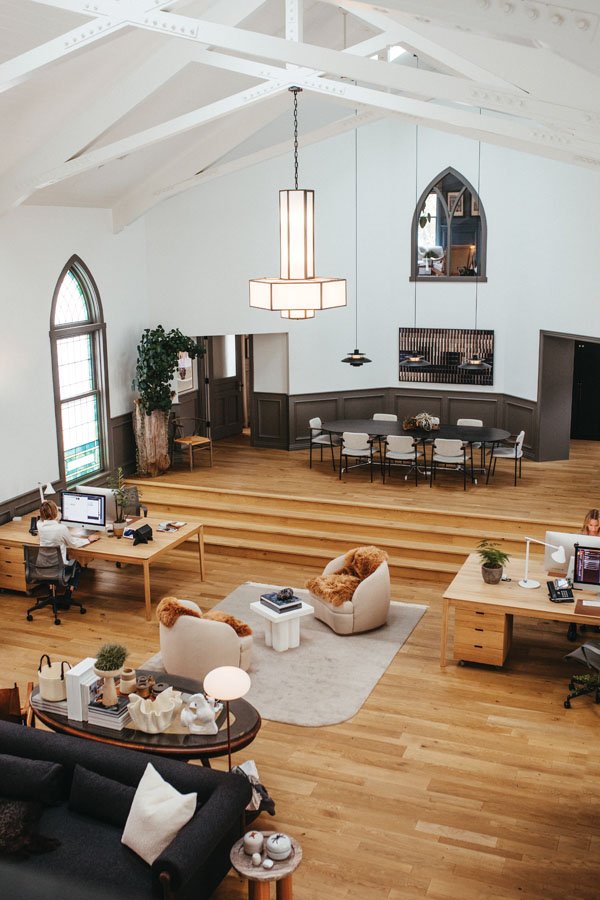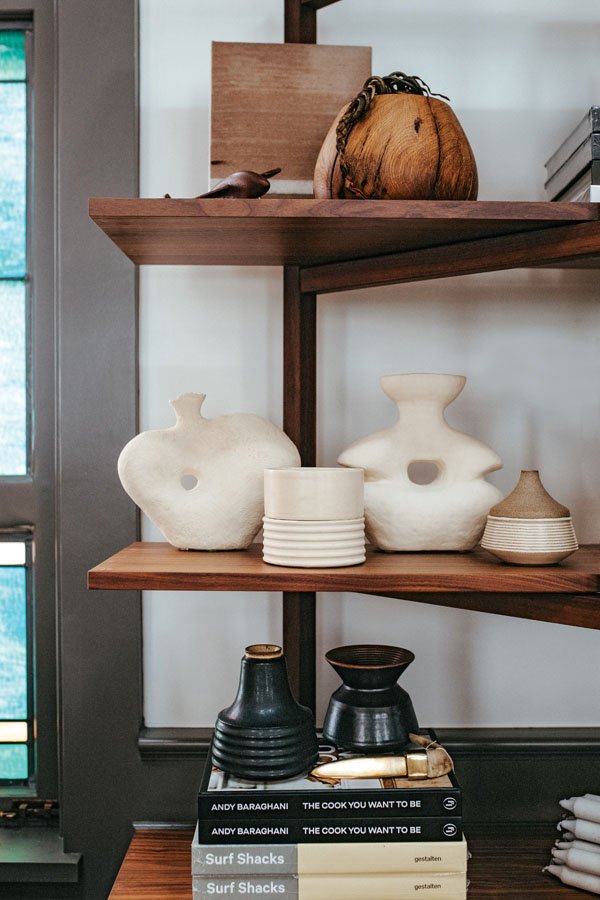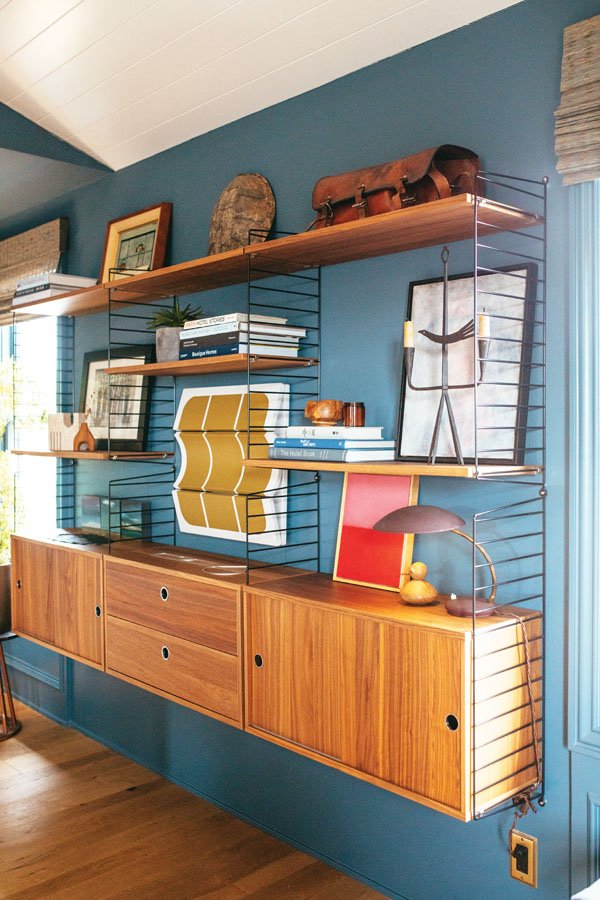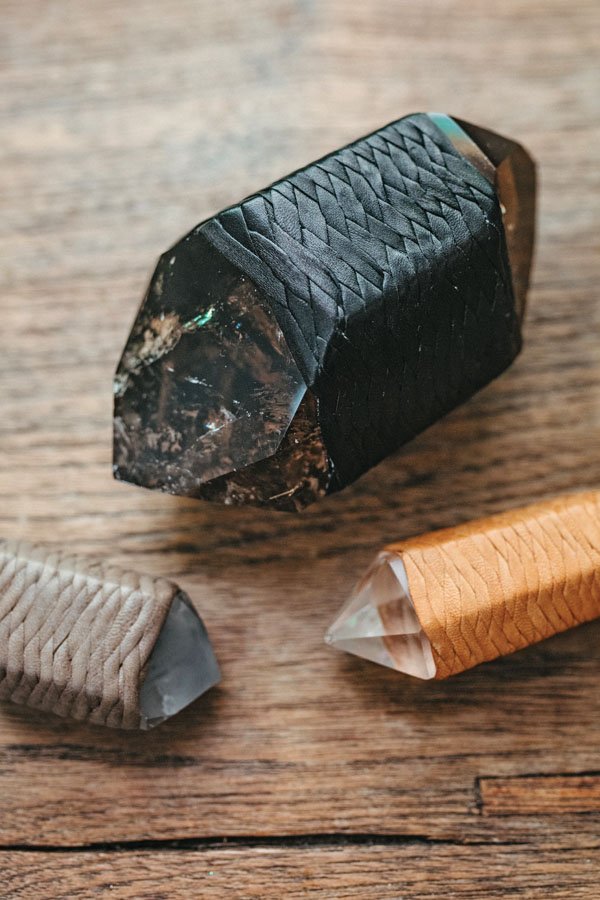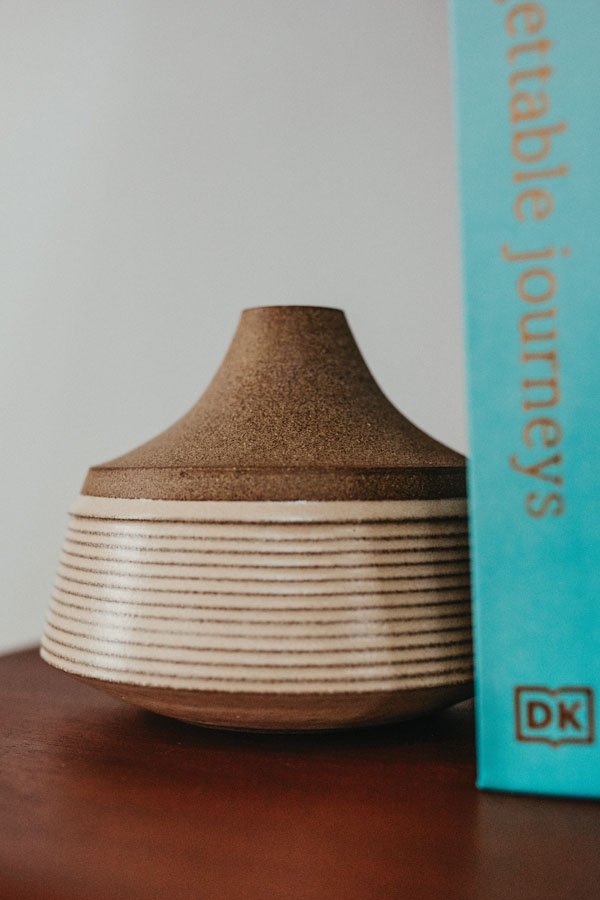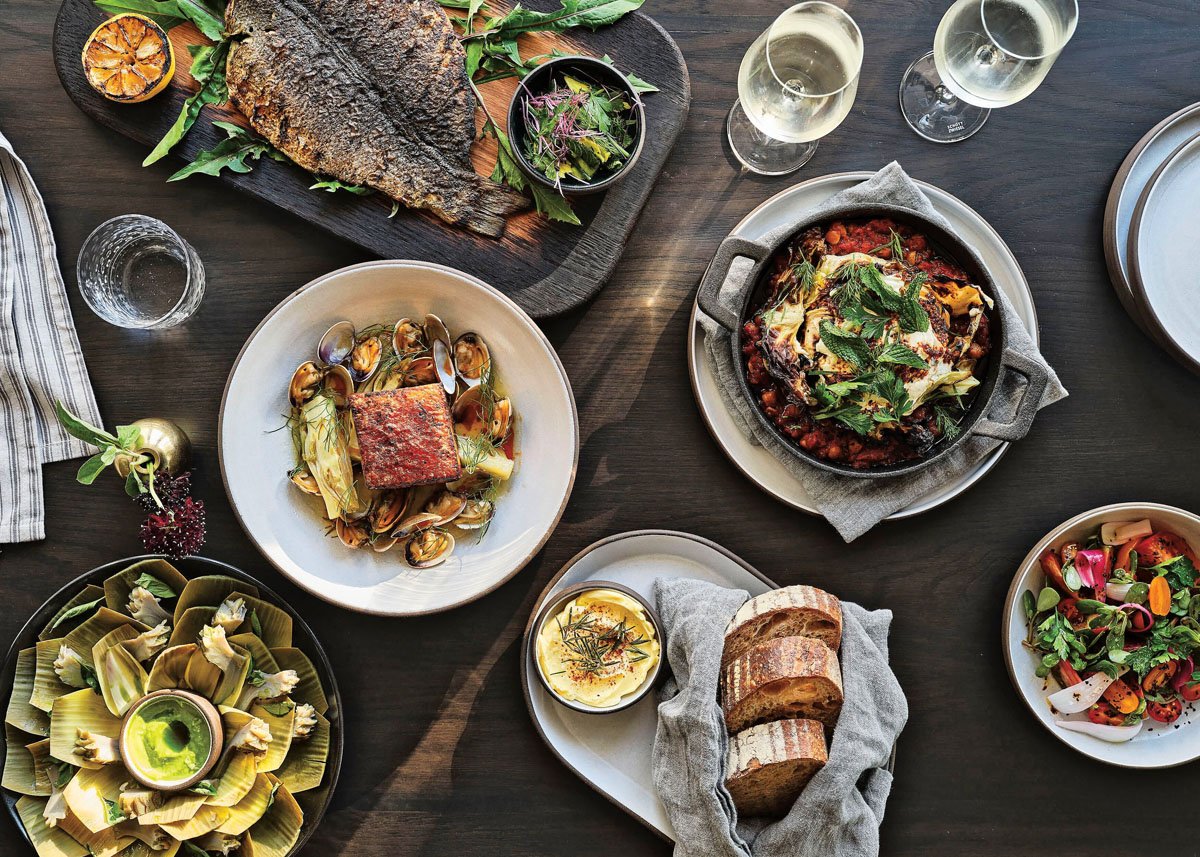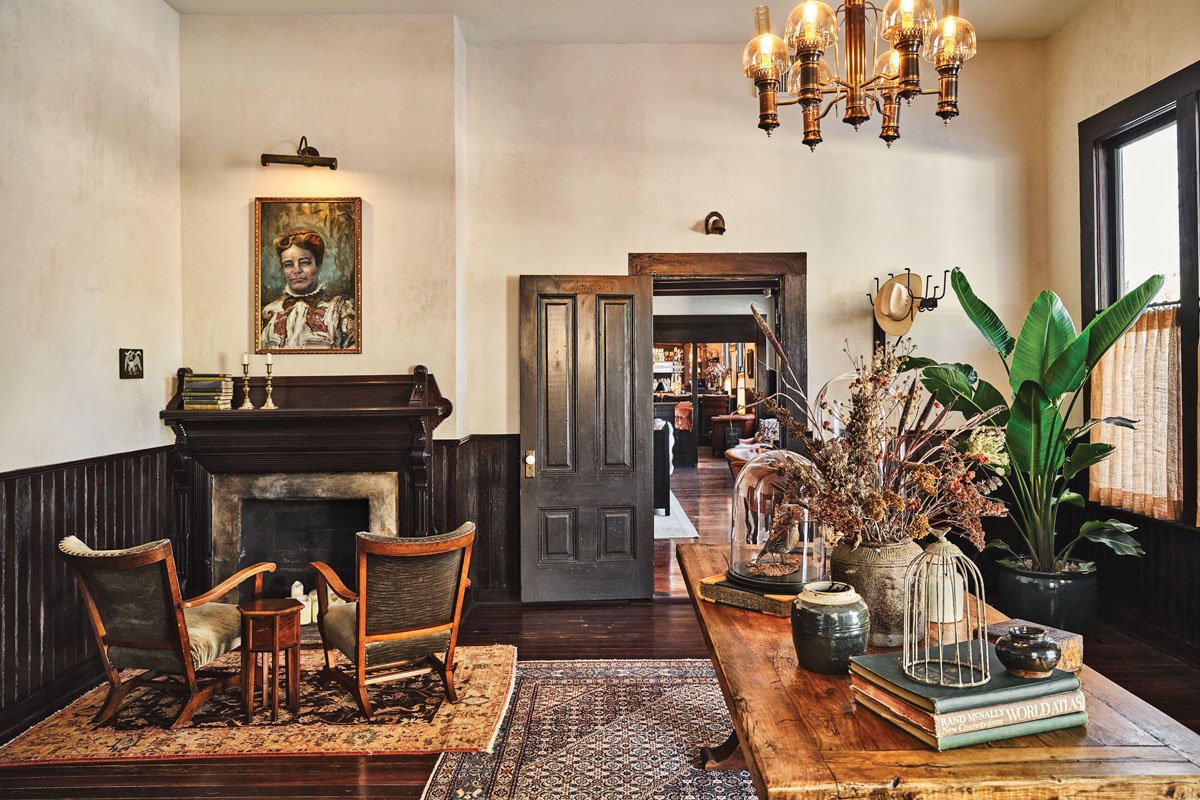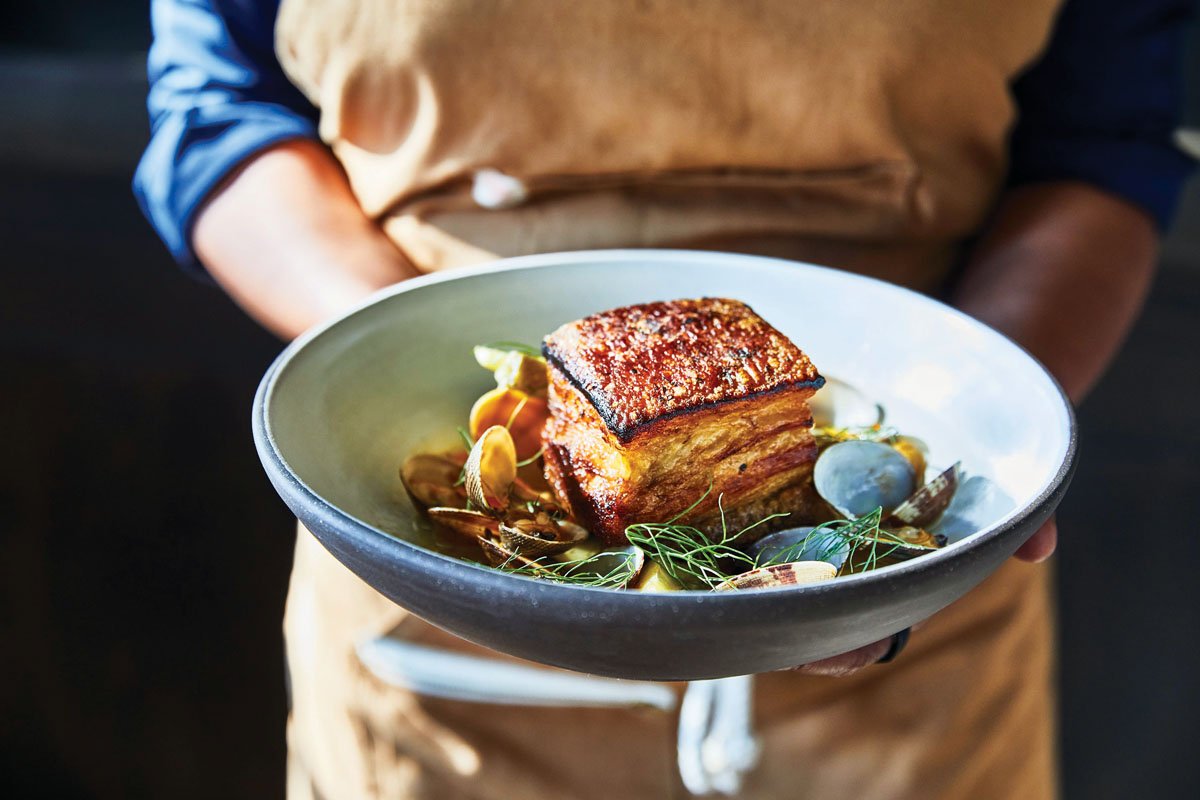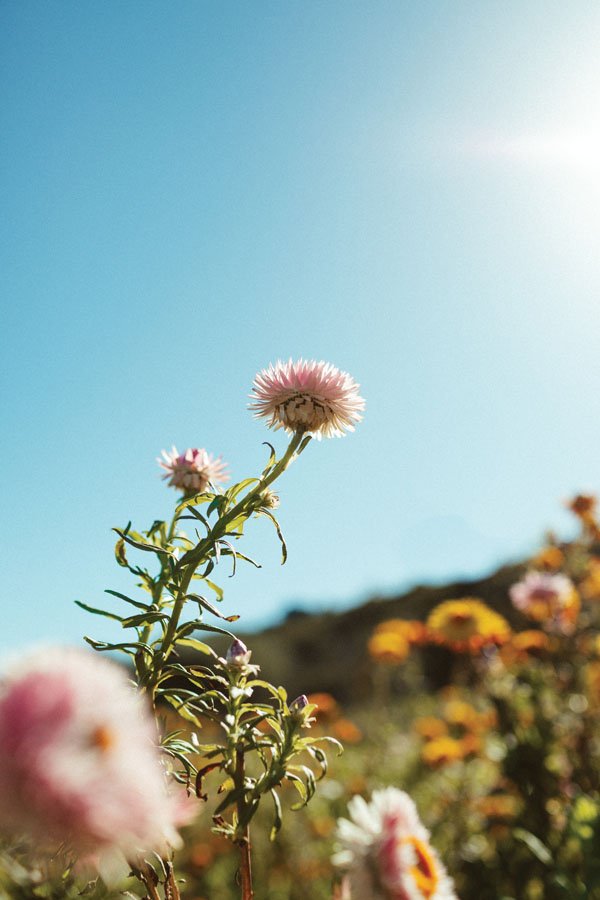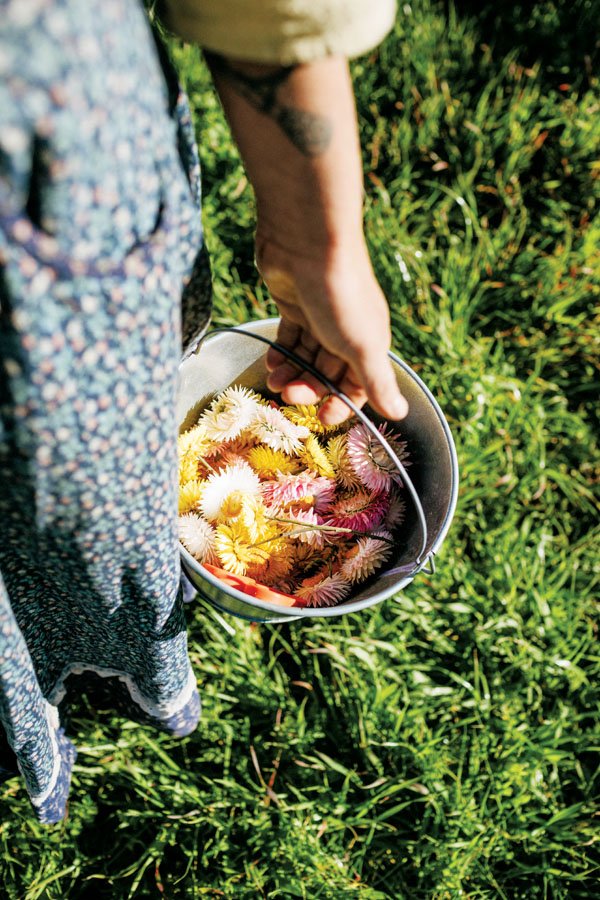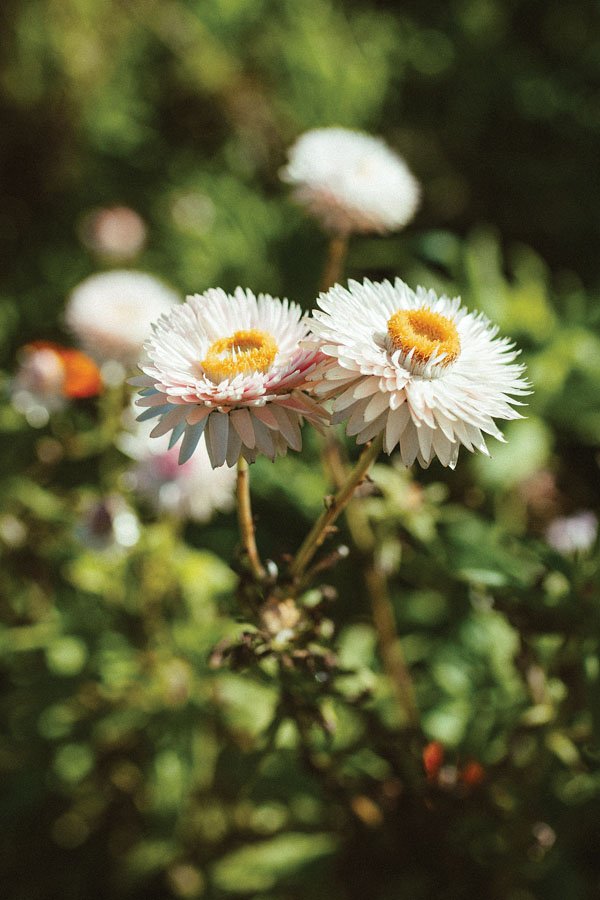Polishing a Hidden Gem
The history of CASA DEL HERRERO—House of the Blacksmith—and of Santa Barbara are inextricably linked.
Written by Joan Tapper
Photographs by Matt Walla/Rizzoli
The history of CASA DEL HERRERO—House of the Blacksmith—and of Santa Barbara are inextricably linked: On the morning of June 29, 1925, George Fox Steedman, owner of his family’s foundry in St. Louis, was staying at the Santa Barbara Club when a devastating earthquake hit the city, leveling most of downtown. He headed for his new home in Montecito, which had just been finished after three years of construction. The Andalusian farmhouse-style residence was fine, cementing architect George Washington Smith’s reputation and distinguishing the home as an early example of Santa Barbara’s prevailing Spanish look.
Steedman and his wife, Carrie, embraced the growing fashion for the Spanish Revival style, and Smith’s plans for the 7,000-square-foot residence incorporated arches, wrought iron, loggias, a red-tile roof, and Moorish accents, like the thousands of colorful tiles that grace fireplaces, fountains, and walls. To furnish the home, the Steedmans commissioned Hispanic art experts Arthur Byne and Mildred Stapley, and traveled with them around Spain, acquiring centuries-old treasures that eventually packed 160 containers.
The Steedmans brought on Ralph Stevens to develop the garden and grounds, which soon encompassed 11 acres. In the back of the house, the garden extends from a loggia down a long grassy allée, while the rest of the extensive grounds are divided into a series of “rooms.” An enclosed Spanish garden opens to a blue-and-white garden with gorgeously tiled benches and a fountain. There’s an herb garden, a boxwood-edged rose garden, an Arizona garden, and extensive orchards. One of the most extraordinary features of the estate is the workshop, where mechanical engineer Steedman designed and crafted silver, other metalwork, and even garden furniture.
Charles Steedman died in 1940; Carrie passed away 22 years later. Medora Steedman Bass, who inherited the house from her parents, lived there until her own death in 1987, after which the family established a foundation that eventually opened the residence and grounds to the public in 1995. Visitors who come for docent-led tours are wowed by the place, which has maintained a low profile for the past three decades.
Now, however, it’s time for the Casa to step into the limelight—and ensure it is ready for its next 100 years. To begin, the foundation is leading up to its centennial with programming that more closely connects the place to the community.
“Medora Steedman Bass wished for the future of Casa to pursue and support the interests of her and her family,” says Edwin Rodriguez Jr., marketing and events director. These include “gardening, architecture, metalwork, silversmithing, restoration of the grounds, global problems, sustainability, population control, family planning, mental health, arts and literature, film, and several others.” Adds board chair Heather Biles, “We are working hard to open the doors of Casa del Herrero to a wider audience and to bring to the community new and interesting ways to experience the Casa.”
Meanwhile, the board is launching an $18 million capital campaign—headed by Palmer and Susan Jackson, who have kicked things off with a $1 million donation—to support preservation of its architectural legacy and protect the institution’s future. The hidden gem will be hidden no more. Santa Barbara architect Marc Appleton says, “The Casa, one of Santa Barbara’s best-kept secrets, is a unique, historic, and special place for the community of Santa Barbara to be able to enjoy, support, and cherish.” 1387 E. Valley Rd., Montecito, casadelherrero.com
See the story in our digital edition
Table Talk
Beautiful books to spark inspiration for your home and garden
Beautiful books to spark inspiration for your home and garden
Written by Lorie Dewhirst Porter
See the story in our digital edition
Style Sanctuary
A historic church has been transformed into a multipurpose studio and shop
A historic church has been transformed into a multipurpose studio and shop
Written by Jessica Ritz
Photographs by Sara Prince
“The partners—in business and in life—eventually realized the opportunity to add something more to the meaningful site”
While the Second Baptist Church that has stood on East Gutierrez Street since 1926 no longer functions as a house of worship, Ryan Brown and Diego Monchamp of the Brown Design Group are continuing its legacy in fresh ways. The historically protected building was originally home to the Black congregation that was established in Santa Barbara in 1910, then to Church of Skatan, the popular skate shop and locals-only spot. After years of physical decline, interior designers Brown and Monchamp, who work in Los Angeles and Santa Barbara and settled in Santa Barbara full time in 2020, are ushering the property into its next chapter with care. As of this spring, it’s the headquarters of their Brown Design Group, featuring a lifestyle boutique appropriately dubbed MINISTRY OF THE INTERIOR.
“It was a great collaborative process to restore it,” Monchamp says of the 4,700-square-foot Gothic Revival building. He and Brown pored over the church’s archival materials and learned about its cultural and social significance from local historians. They repaired the stained glass windows using the original fabricator, designed new custom lighting pendants built by SH Studios, and increased the ceiling height with new trusses and skylights. “DMHA and Henry Lenny Design Studio were fundamental in helping us pull this off,” Monchamp says of their consulting architects.
Restored Gothic arched stained glass windows and new railings have renewed the historic site’s presence on East Gutierrez as Ministry of the Interior; the former sanctuary now houses the team’s working spaces and a welcoming retail experience; Brown’s and Monchamp’s respective studios are on the upper level; “My favorite aspect of our job is the final touches—the accessories, the art, the lighting,” Brown says of offering eclectic goods such as leather-wrapped crystals; partners Brown (left) and Monchamp; more curated finds.
“My favorite aspect of our job is the final touches,” Brown notes. “The accessories, the art, the lighting.” Ministry of the Interior was a way to respond to clients’ wishes to “shop from our shelves” for items like that and also fill a local retail niche.
The inventory features Brown’s finds from his recent travels to 15 countries. Books, small vintage goods, and furnishings from places such as Denmark and Argentina intermingle with ceramics by Chicago-based Julia Archer and braided leather-wrapped crystals crafted by Los Angeles artist Matthew Ready. A seating vignette with a residential feel is another delightful surprise. “My goal was to have it be approachable,” Brown says. Think of this store as a new type of welcoming sanctuary for design lovers. 26 E. Gutierrez St., Santa Barbara, 805-228-4113, interiorministry.com
See the story in our digital edition
The Orchid Chief
Beauty and community meet at Westerlay Orchids
Beauty and community meet at Westerlay Orchids
“One of our core values is community,” Overgaag says. “We donate to just about everything local.”
Written by Jennifer Blaise Kramer
Photographs by Sara Prince
It seems there’s not a benefit, a gala, or an auction in Santa Barbara County that doesn’t have an orchid at its center. And the mastermind behind those appearances is Toine Overgaag, president of WESTERLAY ORCHIDS, who took over the family flower business from his parents and is upping not only its acreage and output but also its philanthropy, which has always been at its heart.
“One of our core values is community,” Overgaag says. “We donate to just about everything local,” which includes the Council on Alcoholism and Drug Abuse’s Amethyst Ball, Dream Foundation’s Flower Empower, and the Santa Barbara Breast Cancer Center. One element of their commitment to the community is an annual fundraiser where every dollar from a week of retail sales directly supports the Carpinteria Education Foundation’s arts and STEM programs. “It’s hyperlocal—a dollar goes so much further at these schools,” he says.
Always looking to make an impact, Overgaag ensured that orchids were popping up everywhere during the pandemic, when supermarkets were scaling back or cutting floral offerings entirely. He launched the “100,000 Orchid Challenge,” in which his team donated flowers to hospitals across California, sending trucks filled with 8,000 orchids each for health care workers to take home. Another initiative led to deliveries for neighbors and friends, lifting spirits when people really needed that blooming surprise.
“There’s a relational aspect to orchids,” says Overgaag. “People feel responsible to take care of them and then share their story.” In fact, he’s heard so many moving orchid tales—about how a grieving person tended to a loved one’s plant or how an orchid led friends to reconnect—that he used it in the company tagline: Every Orchid Has a Story. “You realize you’re in the connection business, not the flower business,” he says. “It’s a privilege to step in and help locally.” 3504 Via Real, Carpinteria, 805-684-5400 ext. 120, westerlay.com
See the story in our digital edition
Hollywood 101
Our world-renowned FILM FESTIVAL finds the sweet spot between Hollywood and international cinema
Our world-renowned FILM FESTIVAL finds the sweet spot between Hollywood and international cinema
Written by Josef Woodard
The 39th annual Santa Barbara International Film Festival, which wrapped on February 17 with the world premiere of Heather Graham’s good-natured rom-com Chosen Family, achieved its long-standing game plan of finding the sweet spot among Hollywood celebrities and Oscar-timed buzz, serious international cinema, feel-good diversions, documentaries, and other facets of film.
As a popular part of its densely packed 10-day (plus one opening night) festival, the celebrity-tribute component was well stocked with Oscar-nominated actors, starting with the prefestival Kirk Douglas award tribute to Ryan Gosling (aka “Ken”). Regrettably, Annette Benning—the only woman on the tribute schedule—had to cancel. But due kudos were given to other powerful actors—Robert Downey Jr., Mark Ruffalo, Paul Giamatti, and Jeffrey Wright (honored for his rare leading role in American Fiction). The Outstanding Directors night focused on Justine Triet (Anatomy of a Fall) and Martin Scorsese (Killers of the Flower Moon), who accepted his award by asserting that “the real gift was getting to make the movies.”
Three peripheral celebrities generated their own special buzz. Lily Gladstone, the first Native American nominated for an Oscar (for Killers) was greeted with a hero’s welcome; she commented, “A win by one of us is a win for all.” Billie Eilish showed up at the Arlington and helped sell out the normally more specialized Variety Artisans panel, noting that her Barbie theme song “picked me up like a little hook lifting me out of a dark place.” Musician John Batiste showed up for a soulful and heartfelt Q&A with festival head Roger Durling, following the poignant doc American Symphony.
In the all-important heart of the program—its 200-plus screening schedule, with an unusually broad geographical sweep—programming director Claudia Puig, in her third year here, summoned an impressive range of cinema. By festival’s end, the avid SBIFF-goers could find resonance in Durling’s opening night comment that “we come to the movies for the feeling of being alive.” sbiff.org
Tibrina Hobson/Getty Images (Brad Pitt; Finneas and Billie Eilish). Rebecca Sapp/Getty Images (Bradley Cooper; Jeffrey Wright; Paul Giamatti; Roger Durling, Justine Triet, and Martin Scorsese; Emma Stone; Mark Ruffalo; Greta Lee, Andrew Scott, Charles Melton, America Ferrera, Lily Gladstone, and Da’Vine Joy Randolph; Cillian Murphy, Robert Downey Jr., and Rob Lowe)
See the story in our digital edition
Bicoastal Book Soirée
President and CEO of Paramount Pictures Brian Robbins and his wife, Tracy, hosted an intimate event at their home in Montecito last weekend to celebrate the release of Jeremiah Brent’s first book, The Space That Keeps You.
Designer Jeremiah Brent toasts his tasteful tome in Montecito
Photography by Eric Charbonneau/Getty Images for Paramount Pictures
President and CEO of Paramount Pictures Brian Robbins and his wife, Tracy, hosted an intimate event at their home in Montecito last weekend to celebrate the release of Jeremiah Brent’s first book, The Space That Keeps You. Brent is a celebrated AD 100 interior designer and a just-announced new cast member of Netflix’s critically acclaimed hit series Queer Eye. The book currently holds the #1 spot on Amazon’s Interior & Home Design list.
Oprah Winfrey, Ellen DeGeneres, Portia de Rossi, Nate Berkus, Jordana Brewster and husband Mason Morfit, Fatima Robinson, fashion designer Anine Bing, and SB Film Festival’s Roger Durling were among guests who attended the event. Three of the stories featured in the book are in the Santa Barbara area so it was a very special place to host the launch of the book.
“Jeremiah has been our dear friend for over six years, and to host his party in a place that so deeply embodies the spirit of his book felt so meaningful. He has truly made our house into a home that reflects the essence of who we are, and we’re so grateful for the personal warmth he brings to every detail of every corner of our home. And then when you consider that three of the stories featured in the book take place in the Santa Barbara area, it was very special to bring everyone together here, and Brian and I were honored to host this event.”
See our Spring 2024 digital edition
Beach Bungalow
Orlebar Brown brings year-round summer to our shores
Written by Lorie Dewhirst Porter
Photography by Meg Sandu
To celebrate the grand opening of the British menswear brand Orlebar Brown at Montecito Country Mart, Santa Barbara Magazine, editorial director Jennifer Smith co-hosted an evening cocktail along with the brand’s founder-designer, Adam Brown, who was fittingly decked out in an immaculate navy wool blazer that’s destined to sell out.
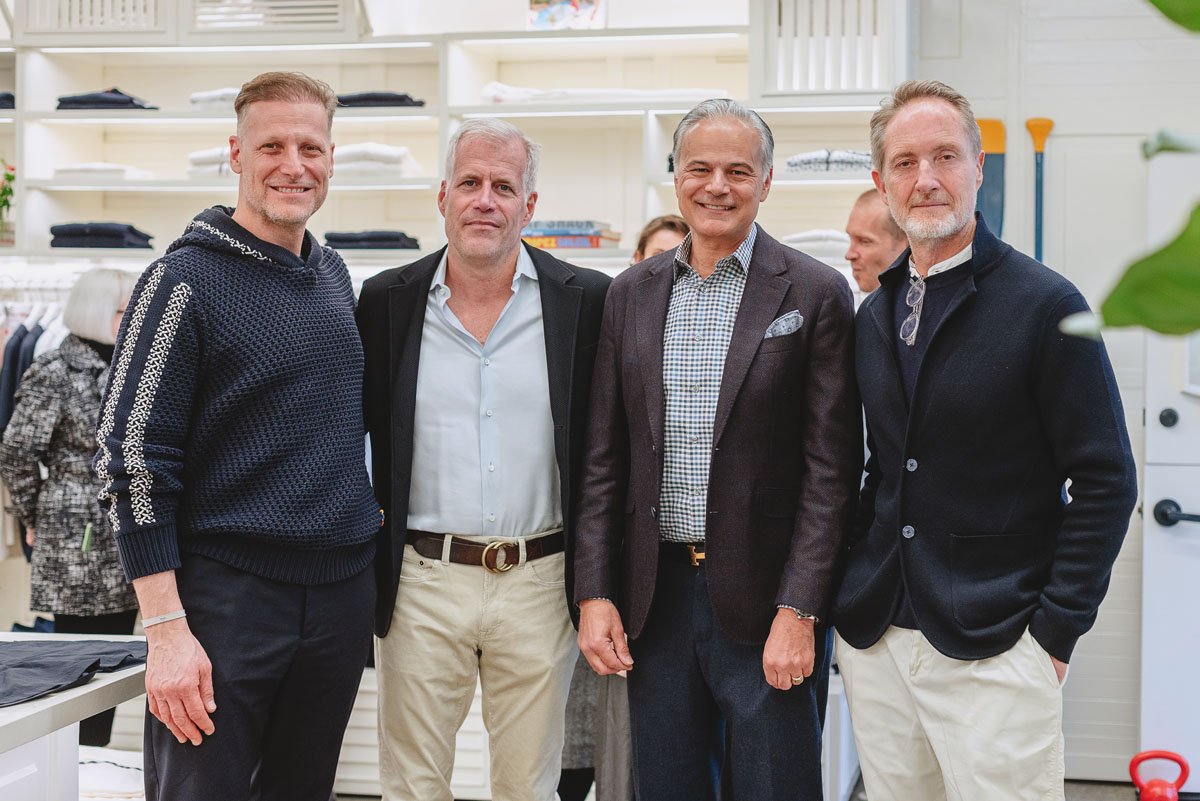

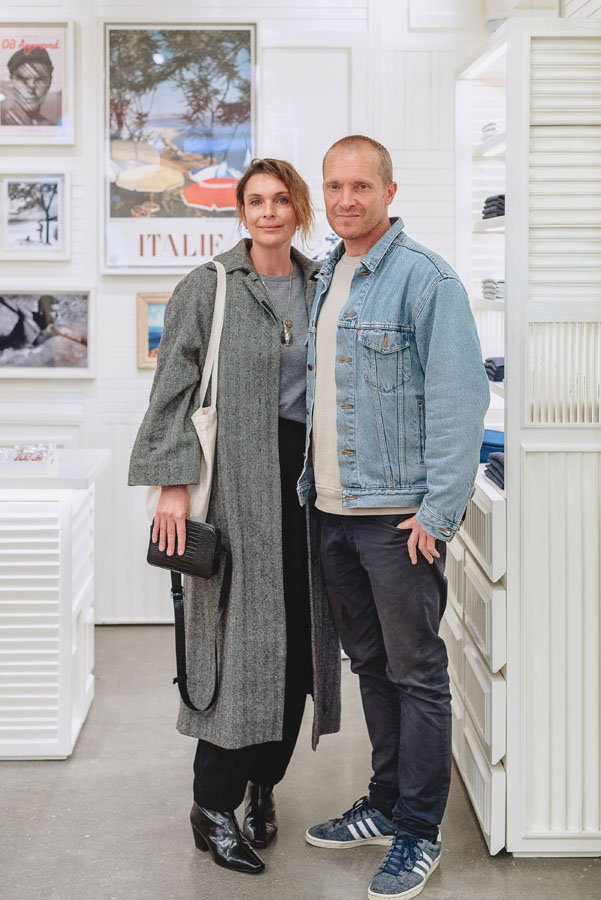
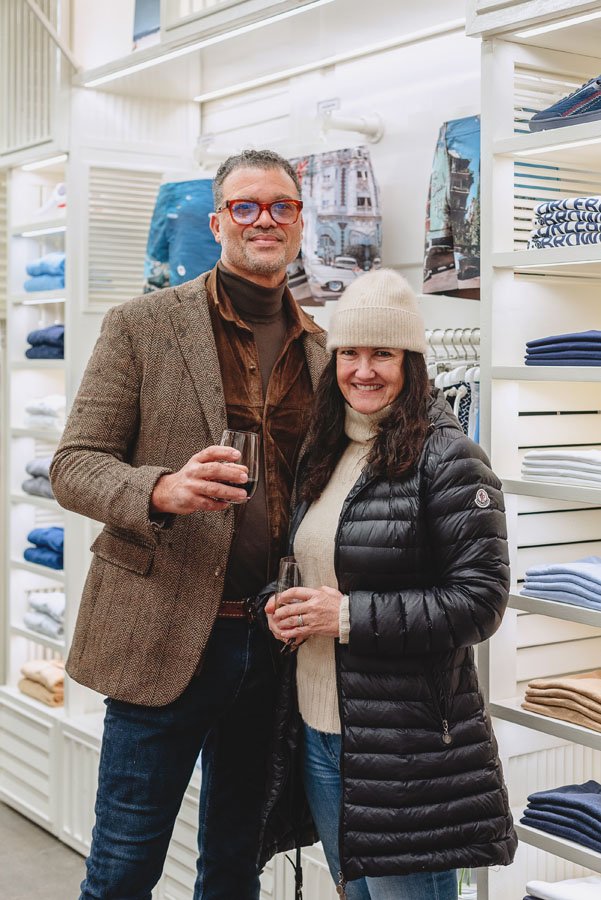

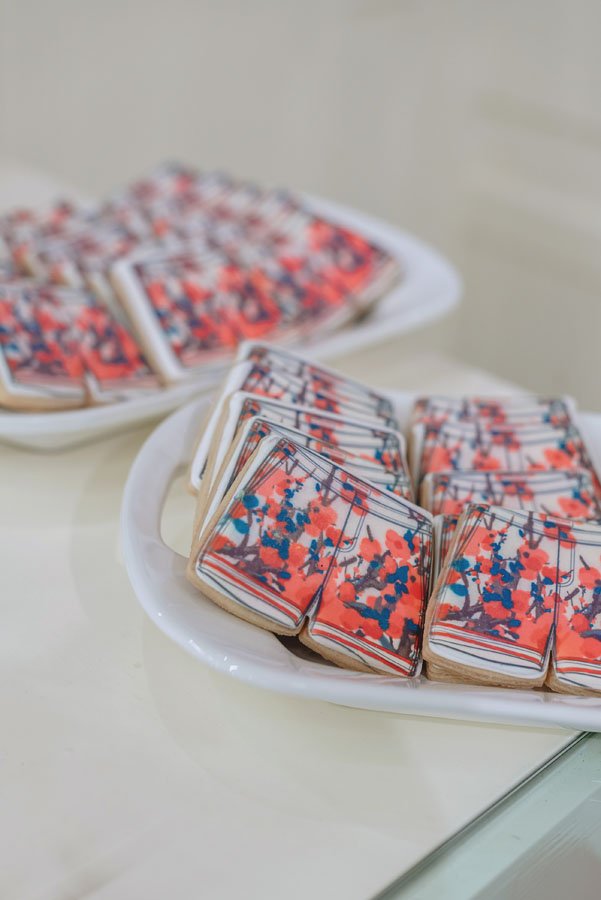
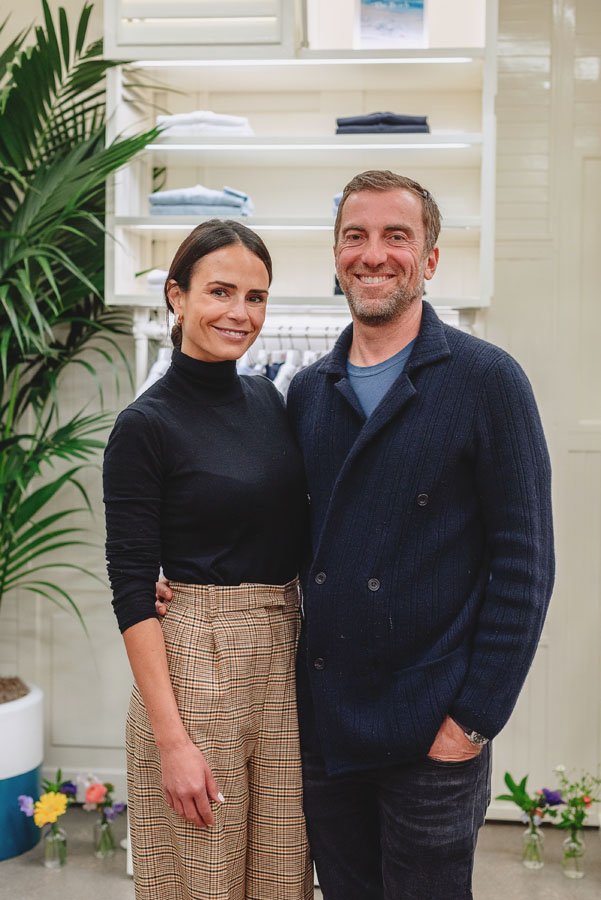

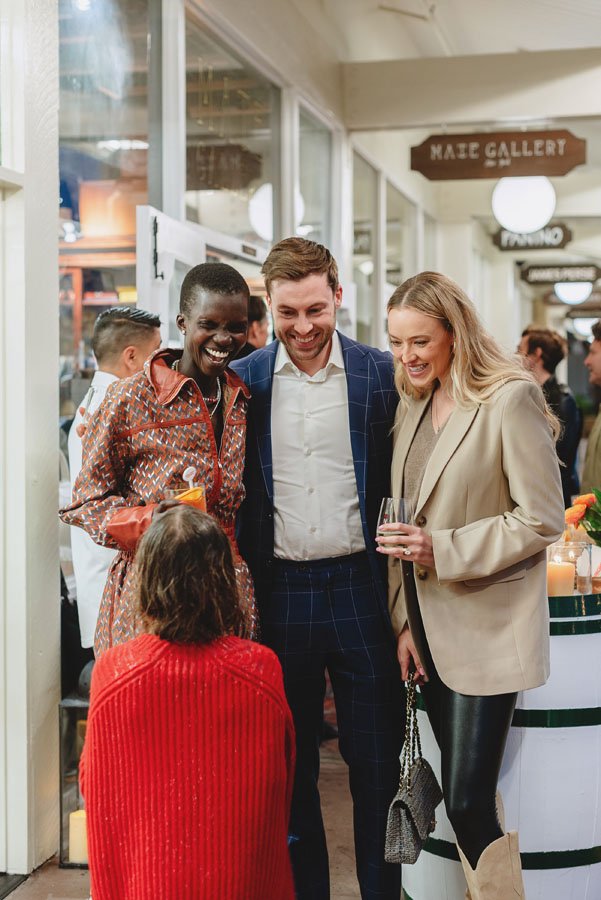
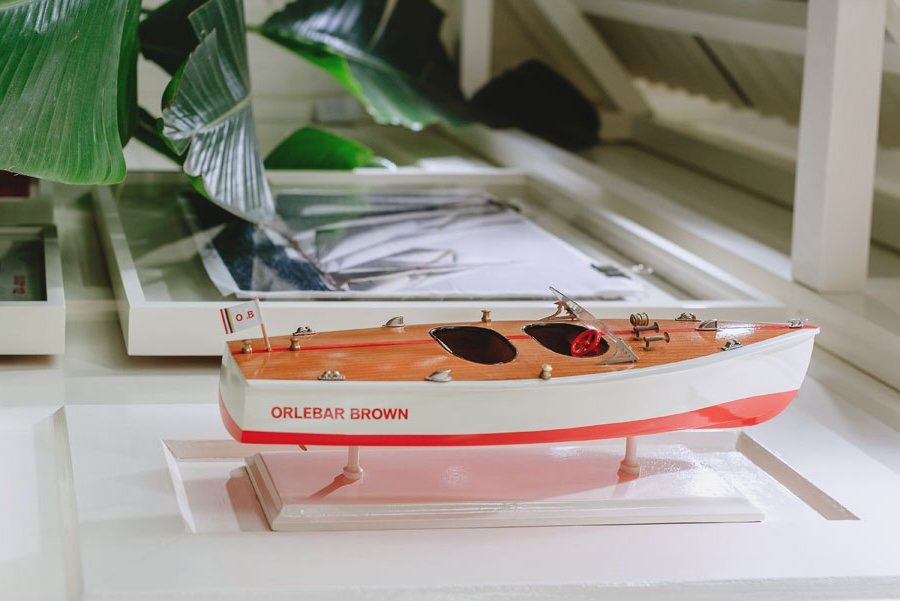


Guests enjoyed catering by Ramon Velazquez (who will be opening his second restaurant, Alma Fonda Fina, at the Mart) while they mingled in the stunning space with its off-white color scheme, a perfect canvas for the brand’s tempting wares. Conceived by chief marketing officer Trevor Hardy, the store’s interior evokes Caribbean oceanfront bungalows, with wide shutters integrated into the displays and an exposed truss ceiling with sheets of wavy metal recalling beach shack roofs. A shiny red-and-white canoe floats overhead, suspended among rows of lights that mimic sea waves.
The opening drew a handsome crowd who enjoyed perusing the racks of men’s swim and resort wear, including design duo Nate Berkus and Jeremiah Brent, Paramount CEO Brian Robbins and wife Tracy, as well as investment guru Mason Morfit and wife, Santa Barbara Magazine cover star actress Jordana Brewster. Also seen scanning the shelves were models Achok Majak and Vanessa Taylor Black, as well as Anne Towbes, Belle Hahn, Kate Kim Shah, Kyle Brace, and artist Cassandria Blackmore.
Owned by luxury powerhouse Chanel, Orlebar Brown has an international reach with stores in England, France, Greece, Turkey, and Australia. U.S. locations include New York, Palm Beach, and Beverly Hills. Renowned for its tailored swimwear, the brand is a celeb favorite; Daniel Craig donned a pair of sky blue Orlebar Brown Setter shorts in the James Bond flick Skyfall. 1016 Coast Village Rd., Montecito, 805-869-2039; orlebarbrown.com.
See our Spring 2024 digital edition
Mattei’s Returns to Life
A 19th-century tavern is reborn as a luxurious eatery
A 19th-century tavern is reborn as a luxurious eatery
Written by Anna Ferguson-Sparks
The INN AT MATTEI’S TAVERN, AUBERGE RESORTS COLLECTION, is now open for dining and resort stays. The “new” Los Olivos hospitality mecca—reborn from the original Mattei’s Tavern, circa 1886—was reimagined by renowned design firm AvroKO. Original buildings now coexist with newly built structures that align with the landmark property’s heritage.
“The Tavern is the main culinary attraction, featuring refined California ranch cuisine.”
The Inn at Mattei’s Tavern includes 67 luxury guest rooms and cottages, a signature spa, and five dining venues. Named for original owner Felix Mattei, Felix Feed & Coffee kick-starts days, while evenings may be spent at The Bar, sipping history-inspired craft cocktails. Poolside, The Shed serves Mediterranean cuisine, and Gin’s Tap Bar pays tribute to a chef at the original Mattei’s with Asian-inspired smokehouse fare. The Tavern is the resort’s main culinary attraction, featuring refined California ranch cuisine.
Two tiers of limited private memberships are also available. The Trailblazers Membership grants access to the fitness and spa facilities, weekday use of the outdoor pool, restaurant perks, private-event discounts, and member events and programming, while The Founders Membership adds a complimentary resort stay, additional pool availability, wellness offerings, and other rewards. 2350 Railway Ave., Los Olivos, 844-837-2999, aubergeresorts.com/matteistavern
See the story in our digital edition
Sweetly Blooming
The top of Rincon Mountain between Carpinteria and Ojai has its own microclimate, explains Mary Gonzalez, who runs SWEET MOUNTAINTOP FARM with her partner, Rob Peed.
Go grow it on the mountain
Written by Joan Tapper | Photography by Sara Prince
The top of Rincon Mountain between Carpinteria and Ojai has its own microclimate, explains Mary Gonzalez, who runs SWEET MOUNTAINTOP FARM with her partner, Rob Peed. Their roughly two-acre plot has ocean breezes, hot summer sun, chilly winters, and rocky clay soil, and it’s perfect for growing flowers and herbs, from which they create teas and tinctures, an herbal skin-care line, decorative garlic braids, mixed bouquets, and colorful wreaths.
Gonzalez, a Carpinteria native, started farming vegetables and melons in 2017 on her father’s avocado ranch, but after the Thomas Fire she became interested in herbal medicine and shifted her crops. Peed, who’s from Orange County, had been producing mead and cider for another Santa Barbara company. He joined Gonzalez in 2019, bringing new products into the business, and now distills their plants for hydrosols and essential oils. The couple sell their wares at farmers’ markets and have a robust online presence. “I like that we have multiple uses for the flowers,” says Gonzalez, who hosts workshops throughout the year next to their flower field. Spring planting begins soon, and their one-year-old son helps keep things lively. “We live where we work. That’s a blessing and a curse,” says Gonzalez, laughing. sweetmountaintop.com
See the story in our digital edition
Culinary Goods
Much like the town of Ojai, Jennie Prebor takes a slow-growth approach to her business.
Written by Jessica Ritz | Photography by Stephanie Helguera
Much like the town of Ojai, Jennie Prebor takes a slow-growth approach to her business. After operating blanchesylvia women’s clothing and accessories shop in the historic downtown arcade since 2016, she’s recently opened culinary store BLANCHESYLVIA KITCHEN in nearby Meiners Oaks. “It emerged in the same way,” she says. “It’s about just finding stuff that I love.” And just as she vouches for merchandise in the dress shop, “there’s nothing in here that I wouldn’t use in my kitchen,” Prebor adds. Named for one of her grandmothers, Blanche, and her mother, Sylvia, the new outpost is a longtime fulfillment of certain obsessions and touchstones, starting with Prebor’s family kitchen in Pennsylvania. In contrast, interior details like polished concrete floors and unvarnished wood shelving stem from a visit to minimalist movement pioneer Donald Judd’s famed pantry in Marfa, Texas, two decades ago. As for the eclectic collected wares in her shop, she hopes “people will want to buy these things as much as I love them,” whether it’s a vintage Greek olive oil jug, Oaxacan pottery, or even a jar of Grey Poupon mustard. Blanchesylvia Kitchen also stocks “local friends,” such as Bonito Coffee Roaster, Beato Chocolates, and Caroline’s Marmalades and Jams.
Here, the boundaries between home, life, and community overlap, as evidenced by the olive oil bottled from fruit in the grove owned by Prebor and her husband, architect Fred Fisher. “It’s very personal,” she says of the project. 443 W. El Roblar, Meiners Oaks, @blanchesylviaojai
See the story in our digital edition
Stage Presence
For a century and a half, a wealth of talent has graced the stage of the Lobero Theatre, which is celebrating its 150th anniversary this month.
Written by Joan Tapper
For a century and a half, a wealth of talent has graced the stage of the Lobero Theatre, which is celebrating its 150th anniversary this month. Founded as an opera house in 1873 by Jose Lobero, the venue is the oldest continually operating theater in California and the fourth oldest in the country. The earliest years included appearances by the Tennessee Jubilee Singers; boxer John L. Sullivan, who tried a new career as an actor; and Susan B. Anthony.
In 1924 architect Lutah Maria Riggs, in partnership with George Washington Smith, redesigned the theater in the Spanish Colonial style that would come to epitomize Santa Barbara’s look after an earthquake the following year flattened much of downtown. The theater was undamaged, however, and in the following decades has welcomed classical musicians like Sergei Rachmaninoff and Yehudi Menuhin, actors like Humphrey Bogart and Lucille Ball, jazz greats like Charles Lloyd and Dizzy Gillespie, and folk/rock performers like Tom Waits, Neil Young, and the late David Crosby.
The Lobero interior has retained its graceful elegance with fluted columns that ring the auditorium, a circular chandelier, and an elaborate painted ceiling. And, of course, its support of the arts, which has only gotten stronger over 150 years.
Architect Lutah Maria Riggs put her stamp on the redesign of the Lobero Theatre in 1924, with a Spanish Colonial exterior and graceful interior details. This archival photo shows a couple of the surrounding columns, the painted ceiling modules, and the chandelier, along with stage decor.
See the story in our digital edition
A Taste of the World
When Santa Barbara–based Nati Smith sat down to write Mish and the Recipe for Adventure…
Written by Joan Tapper | Photography by Sara Prince
When Santa Barbara–based Nati Smith sat down to write Mish and the Recipe for Adventure (Wise Ink Creative Publishing, $23), a heart-warming children’s book with illustrations by Guillermo Alonso, she had several goals in mind. As a Jerusalem native, Smith aimed to introduce children to international culture through fun recipes from around the world, while also bringing mindfulness to the kitchen. Her story focuses on a young rabbit, Mish, who enters a cooking competition against other talented chefs. As Mish advances to the finals, in part thanks to spiritual practices that help her keep calm, she wows the judges with a comforting childhood favorite made with a secret ingredient—love.
Smith says, “Mish is a journey of friendship, food, culture, believing in yourself, and overcoming obstacles with affirmation and love.” That message has resonated with children and adults alike. “Many parents have shared pictures of their kids reading the book along with loving comments about their experience with Mish,” she adds. “All of these incredible reactions have filled my heart with love and smiles and given me much inspiration and encouragement for the upcoming chapters in the Mish series.”
Nati Smith’s Shakshuka
About 6 medium tomatoes
1 tablespoon avocado oil
1 yellow bell pepper, seeds removed and chopped roughly
1 red bell pepper, seeds removed and chopped roughly
1 bunch green onions, chopped (green parts only)
3 to 4 artichoke hearts, thickly sliced
2 handfuls cherry tomatoes, halved
½ to 1 teaspoon dried oregano
½ to 1 teaspoon dried basil
1 teaspoon paprika
½ teaspoon Himalayan pink salt
¼ teaspoon freshly ground black pepper
2 handfuls fresh spinach leaves
5 to 6 eggs
Za’atar
Tahini
Maldon smoked sea salt (optional)
Sumac
Olive oil
Fresh cilantro, chopped, for garnish
A tablespoon of love
Bring a pot of water to a boil. Meanwhile, use a sharp knife to score each medium tomato on the bottom (opposite the stem end), making an X. Keep any juice that is released. Drop the tomatoes into the boiling water and cook for 1 minute. Transfer to a bowl of ice water. With a knife or a spoon, peel off the skin and cut the tomatoes into rough cubes or slices.
Place the avocado oil in a large pan over medium heat. Add the chopped bell peppers and sauté for a few minutes, until soft. Add the green onions and artichoke hearts and continue to cook. Add the cherry tomatoes and boiled tomatoes (with the juices they released while cutting). Stir and add the oregano, basil, paprika, Himalayan salt, and black pepper. Stir well. Cook for about 10 minutes, stirring occasionally. If you need more liquid, add hot water, but just a little at a time—you want the consistency to be thick, not watery.
Add the spinach and stir. Taste and add more seasoning as needed.
Crack the eggs and add them to the shakshuka stew. Sprinkle each egg with salt, black pepper, and za’atar.
Cover with a lid and cook just until the egg yolks are a bit runny and soft. Alternatively, you can put the pan, uncovered, in an oven that was preheated to 350°F. Bake until the eggs are a bit runny and soft.
When the eggs are done, drizzle them with tahini and sprinkle with Maldon salt (if using) and sumac. Drizzle with a bit of olive oil and garnish with fresh cilantro.
See the story in our digital edition
Cactus Makes Perfect
Cementing her reign as the textile queen, California-based interior and furniture designer Natasha Baradaran recently debuted her latest innovation: Livwell cactus leather.
Livwell cactus leather stool
Written by Anush J. Benliyan
Cementing her reign as the textile queen, California-based interior and furniture designer Natasha Baradaran recently debuted her latest innovation: Livwell cactus leather. An industry first, the sustainable vegan fabric is crafted from the sun-dried mature leaves of cactus, which she sources from an environmentally conscious organic ranch in central Mexico. The collection launched with a campaign aptly photographed at Ganna Walska Lotusland, where over 300 species of the perennial plant bask under the Montecito sun. natashabaradaran.com.
See the story in our digital edition
Viva Magenta
Top picks in the season’s hottest shade
Top picks in the season’s hottest shade
Edited by Charlotte Bryant
See the story in our digital edition
Design Duo
The power couple behind Cove House share their 2023 must haves
The power couple behind Cove House share their 2023 must haves
Edited by Charlotte Bryant | Photography by Tessa Neustadt, Ally Simons (Portrait)
SANTA BARBARA LIGHTS is our go-to for exterior lights. Karen and her husband have sourced the most incredible collection of antique lights.
Kate and Mimi at THE WELL SUMMERLAND are so lovely, and they have the most insane selection of pots, furniture, art, and more. We just bought two leather-slipcovered armchairs for Casa Plunkett.
Ceramics, baskets, and antique bells from India are perfect for decorating a shelf from DOMECIL, a little gem that has a gorgeous selection of home wares.
JENNI KAYNE in Montecito has the best pillows, and her upholstered Pacific bed is classic.
We recently scored the most beautiful antique dresser from SUMMERLAND ANTIQUE COLLECTIVE. We love melding old and new.
Follow @cove.house for more on #casavista and #casaplunkett projects
See the story in our digital edition
Meadowscaping
Rustic and rattan tones for indoor/outdoor living
Rustic and rattan tones for indoor/outdoor living
Edited by Charlotte Bryant
See the story in our digital edition
Pillow Talk
Global goods at a textile candy store
Global goods at a textile candy store
Written by Jennifer Blaise Kramer | Photographs by Sara Prince
Jean-Philippe Cajuste, aka “The Pillow Man,” earned his nickname selling pillows made from vintage textiles his wife, Tamara, would collect from all over the world while working as a flight attendant. “I’d meet her at the airport on a layover with a black duffle bag—it looked like a full-on drug deal,” he says. Whenever they’d travel together, he’d pack hundreds of pillow covers—from Jaipur prints to Chinese batiks—in hues that were fitting for the destination, such as coastal blues for Nantucket or the Hamptons. Inevitably all the pillows would sell out, which essentially funded the couple’s trips.
Those same seaside hues caught the eye of their first client, a buyer from local design store Rooms & Gardens, resulting in frequent trips and an eventual move to Santa Barbara. The Cajustes settled their family into Montecito, where home is a “laboratory,” and their first retail outpost, INDIAN PINK, puts a face to the brand so many designers, decorators, and celebrities have come to love. The bohemian State Street boutique feels like a textile candy store, full of pastel block-printed pajamas, vintage upholstered furniture, and countless pillows. But rather than adding to the cliché of couples constantly fighting over too many throw pillows on the bed, Jean-Philippe often talks people into just one. “I hear it daily—if I buy another pillow my husband’s going to kill me,” he laughs, admitting it’s easy to overdo it. “Sometimes it’s like, where’s there to sit?” 1307 State St., Santa Barbara, 310-908-5011, indianpinkshop.com
See the story in our digital edition
Chic & Proper
Impeccable details and eclectic inspiration for your travels
Impeccable details and eclectic inspiration for your travels
Kelly Wearstler’s turn as the design partner for PROPER HOTELS has been one of the most fascinating hostelry stories of the past decade. Beginning with a landmark San Francisco property in 2017, the brand grew to include outposts in Santa Monica and Austin in 2019, before rounding out its portfolio with a downtown Los Angeles location in 2021. The disparate venues showcase the range of Wearstler’s work, from the restoration of a historic 1920s building in L.A. to a sculptural new build from Handel Architects in Texas.
For Curlett & Beelman’s California Renaissance Revival landmark, Wearstler has drawn on Spanish, French, and Moroccan influences, along with Mexican modernism, deploying more than 100 types of tile throughout the building, along with vintage rugs and furniture and handmade ceramics and murals. The result is an eclectic gem of a hotel with a residential feel and an outsize spirit. Where else would you find a suite with its own private swimming pool?
In Austin, the contrast between the concrete, glass, and metal exterior of the property and the vivid, textured interior points up the paradoxes that best represent this great state. Travertine tile mined directly from local quarries and a patchwork of vintage rugs and the work of Texan craftspeople mark this hotel as a love letter to the landscape and artistic heart of the surrounding city. properhotels.com
Brian De Lowe’s Austin Food Scene
Besides Austin Proper’s stellar Mediterranean restaurant THE PEACOCK and the alfresco LA PISCINA, the cofounder and president of Proper Hotels gives us his best bets for lunch and dinner in this Texas town.
SAMMIE’S (sammiesitalian
.com) New old-school Italian spot. Chicken parm!
SUERTE (suerteatx.com) Handmade tortillas, suadero tacos, and amazing aguachiles.
LAUNDERETTE (launderetteaustin.com)
East Side American fusion. Great place for dinner.
JUSTINE’S (justines1937.com) East Side French. Make sure to sit outside in the garden for dinner.
CLARK’S (clarksaustin.com) Perfect neighborhood spot that I could eat at three times a week.
JEFFREY’S (jeffreysofaustin.com) Fine dining. Great vibe, especially in the bar. Try the burger.
LORO (loroeats.com) Asian-BBQ fusion (a concept from Aaron Franklin of Franklin BBQ and Tyson Cole of Uchi).
POOL BURGER (poolburger.com) Super-casual tiki vibe.
HOWARD’S (howardsaustin.com) + ROSIE’S (rosiesaustin.com) Newly opened. Fun dance party at Howard’s and wine bar at Rosie’s.
Hive of Activity
Just minutes from downtown Santa Ynez, the Shunem Bread House provides an architectural contrast to the surrounding countryside.
Written by Anna Ferguson-Sparks | Photography by Lindsey Drewes
Just minutes from downtown Santa Ynez, the Shunem Bread House provides an architectural contrast to the surrounding countryside. Owners and builders Leyla and Brad Williams, proprietors of Solvang’s Good Seed Coffee Boutique, worked with Ulrick Design on the unusual structure. It’s tied to the Williams’s nonprofit, Sky Roots, through which Leyla conducts workshops on homestead arts and Hebraic culture. Named for the biblical woman who sheltered the prophet Elisha, Shunem Bread House is a retreat for visitors and a space to meet, educate, and entertain.
The building’s cantilevered upper level has a beehive form inspired by the healing properties of honey and its importance in the Bible, while the lower level houses a metaphorical hive of activity. Upstairs are two bedrooms with organic Coyuchi bed linens and one full bath with a redwood slab counter and a Stone Forest sink with Brizo brass fixtures. The living space features a wet bar and opens to a covered patio and a sundeck with 360-degree views of mountains and vineyards.
The first floor’s dining area, library, and lounge include an antique drafting desk transformed into a Torah ark by local carpenter Matt Rogers and a table and chairs by Central Coast woodworker Ben Riddering. In the lower-level commercial kitchen—where Leyla bakes Good Seed’s heritage-grain sourdough breads—is a chandelier handcrafted by Brad from an antique threshing sledge and incorporating pendants from Alison Berger Glassworks.
In the future, Shunem Bread House plans a picnic-lunch program and pop-up culinary events. $650/night. Available through airbnb.com.
See the story in our digital edition
Natural Preserve
Homeowners who build in Montecito are frequently frustrated with the county ordinance that protects old-grown oaks and complicates construction plans on many properties throughout our beautiful canyons.
Written by Charles Donelan | Photography by Sara Prince
Homeowners who build in Montecito are frequently frustrated with the county ordinance that protects old-grown oaks and complicates construction plans on many properties throughout our beautiful canyons. When it came to replacing a modest ranch house that was edged by an oak grove on San Ysidro Creek, however, the owners embraced the legal limitations and trusted their project to an innovative plan for the one-acre site, tapping architect Peter Tolkin of TOLO, landscape designer Wade Graham, and Rich Coffin of RHC Construction for the bold project.
“The original ranch house sat at the edge of the lot; the ‘branch house’ would arise in the heart of the property, with the grove of protected oaks surrounding it.”
An unconventional site plan allowed the house to nestle within the oak grove without crossing the drip lines of the protected trees.
The team traced the outlines of the existing oaks as large circles and devised a pinwheel-shaped “branch house” that would fit into the forest like another large tree. They cantilevered the branchlike sections of the house off the ground, allowing for water and even debris to flow underneath. Then Tolkin came up with an exterior that would interact with the garden over time—a sheath of custom copper shingles that develops a rich patina and blends with the colors of the oaks.
In designing the landscape, Graham counterbalanced the curvilinear organic volumes of the house with an imaginative site plan that introduced straight lines and hard angles. As excavation pulled boulders from the ground, Graham had them milled and fitted together to form angular benches.
The entire branch house project represents a significant advance in residential design. By living and building with the oaks rather than against them, the house reveals a path forward for Montecito’s next century. toloarchitecture.com; wadegraham.com; rhcconstructioninc.com.





